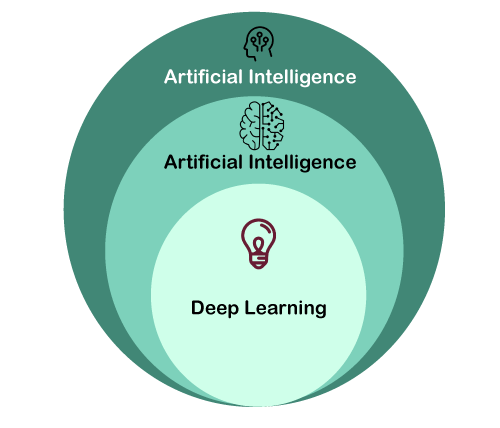- 机器学习和深度学习的区别
- 机器学习和深度学习的区别(1)
- 机器学习和深度学习的区别
- 机器学习和深度学习
- 机器学习和深度学习(1)
- 机器学习-深度学习
- 机器学习-深度学习(1)
- 人工智能与机器学习与深度学习之间的区别(1)
- 人工智能与机器学习与深度学习之间的区别
- PyTorch-机器学习与深度学习
- PyTorch-机器学习与深度学习(1)
- 深度 Q 学习(1)
- 深度学习 (1)
- 深度 Q 学习
- 机器学习中的 P 值
- 机器学习 (1)
- C++中的机器学习(1)
- 机器学习中的 P 值(1)
- C++中的机器学习
- 学习 python 机器学习 - 任何代码示例
- Python深度基础机器学习
- Python深度基础机器学习(1)
- 机器学习 python (1)
- 深度学习和机器学习对数据结构和算法的需求(1)
- 深度学习和机器学习对数据结构和算法的需求
- 大数据和机器学习的区别
- 大数据和机器学习的区别(1)
- 如何开始学习机器学习?
- 如何开始学习机器学习?(1)
📅 最后修改于: 2020-09-29 03:28:28 🧑 作者: Mango
机器学习和深度学习之间的区别
机器学习和深度学习是数据科学的两个主要概念,也是人工智能的子集。大多数人认为机器学习,深度学习以及人工智能是相同的流行语。但实际上,所有这些术语都是不同的,但彼此相关。
在本主题中,我们将学习机器学习与深度学习有何不同。但是在学习差异之前,首先让我们简要介绍一下机器学习和深度学习。

什么是机器学习?
机器学习是人工智能和不断发展的技术的一部分,它使机器能够从过去的数据中学习并自动执行给定的任务。
机器学习使计算机可以自己学习经验,使用统计方法来改进性能并预测输出,而无需进行显式编程。
ML的流行应用是电子邮件垃圾邮件过滤,产品推荐,在线欺诈检测等。
一些有用的ML算法是:
- 决策树算法
- 朴素贝叶斯
- 随机森林
- K均值聚类
- KNN算法
- Apriori算法等
机器学习如何工作?
机器学习模型的工作可以通过识别猫或狗的图像的示例来理解。为了识别这一点,ML模型将猫和狗的图像作为输入,提取图像的不同特征(例如形状,高度,鼻子,眼睛等),应用分类算法,并预测输出。考虑下图:

什么是深度学习?
深度学习是机器学习的子集,或者可以说是一种特殊的机器学习。它在技术上与机器学习的工作方式相同,但是功能和方法不同。它受到称为“神经元”的人脑细胞功能的启发,并导致了人工神经网络的概念。它也称为深度神经网络或深度神经学习。
在深度学习中,模型使用不同的层来学习和发现来自数据的见解。
深度学习的一些流行应用是自动驾驶汽车,语言翻译,自然语言处理等。
一些流行的深度学习模型是:
- 卷积神经网络
- 递归神经网络
- 自动编码器
- 经典神经网络等
深度学习如何工作?
我们可以通过识别猫还是狗的相同示例来理解深度学习的工作。深度学习模型将图像作为输入,并将其直接馈送到算法,而无需任何手动特征提取步骤。图像传递到人工神经网络的不同层,并预测最终输出。
考虑下图:

机器学习和深度学习之间的主要比较
让我们根据不同的参数了解这两个术语之间的主要区别:
| Parameter | Machine Learning | Deep Learning |
|---|---|---|
| Data Dependency | Although machine learning depends on the huge amount of data, it can work with a smaller amount of data. | Deep Learning algorithms highly depend on a large amount of data, so we need to feed a large amount of data for good performance. |
| Execution time | Machine learning algorithm takes less time to train the model than deep learning, but it takes a long-time duration to test the model. | Deep Learning takes a long execution time to train the model, but less time to test the model. |
| Hardware Dependencies | Since machine learning models do not need much amount of data, so they can work on low-end machines. | The deep learning model needs a huge amount of data to work efficiently, so they need GPU’s and hence the high-end machine. |
| Feature Engineering | Machine learning models need a step of feature extraction by the expert, and then it proceeds further. | Deep learning is the enhanced version of machine learning, so it does not need to develop the feature extractor for each problem; instead, it tries to learn high-level features from the data on its own. |
| Problem-solving approach | To solve a given problem, the traditional ML model breaks the problem in sub-parts, and after solving each part, produces the final result. | The problem-solving approach of a deep learning model is different from the traditional ML model, as it takes input for a given problem, and produce the end result. Hence it follows the end-to-end approach. |
| Interpretation of result | The interpretation of the result for a given problem is easy. As when we work with machine learning, we can interpret the result easily, it means why this result occur, what was the process. | The interpretation of the result for a given problem is very difficult. As when we work with the deep learning model, we may get a better result for a given problem than the machine learning model, but we cannot find why this particular outcome occurred, and the reasoning. |
| Type of data | Machine learning models mostly require data in a structured form. | Deep Learning models can work with structured and unstructured data both as they rely on the layers of the Artificial neural network. |
| Suitable for | Machine learning models are suitable for solving simple or bit-complex problems. | Deep learning models are suitable for solving complex problems. |
机器学习和深度学习中选择哪一个?
正如我们所看到的,对ML和DL进行了简要介绍并进行了一些比较之后,现在说明为什么以及需要选择哪一个来解决特定问题。因此,可以通过给定的流程图来理解:

因此,如果您有大量数据和高硬件功能,请进行深度学习。但是,如果您没有它们,请选择ML模型来解决您的问题。
结论:总而言之,我们可以说深度学习是具有更多功能和不同工作方式的机器学习。选择其中任何一个以解决特定问题取决于数据量和问题的复杂性。